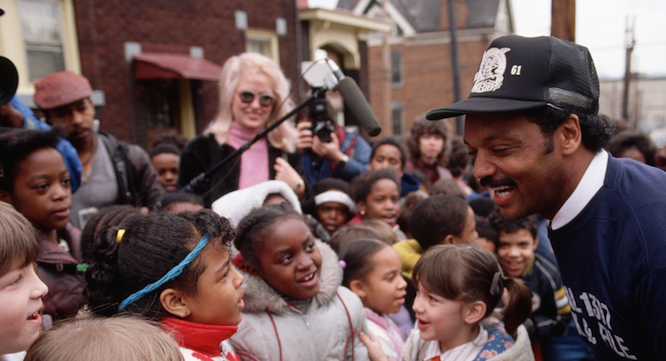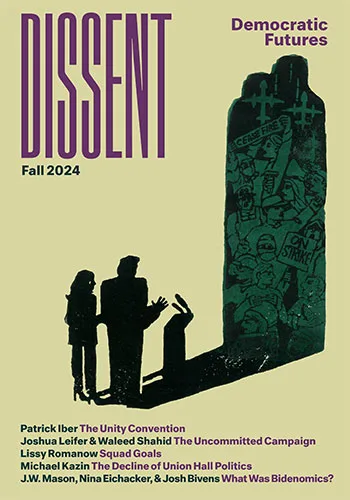The Reactionary Heartland Is a Myth
The Reactionary Heartland Is a Myth
Don’t believe the media stereotype. An inclusive left populism has won in the Midwest before, and it can win again.

Over the course of the presidential primary campaign, we’ve seen a similar scene play out over and over: candidates giving regionally specific performances meant to convey their relatability and authenticity. This May, for example, at a Wisconsin town hall event televised on Fox News, presidential candidate Amy Klobuchar of Minnesota attempted to woo her overwhelmingly white audience by underscoring her sensible Midwestern roots. Dubbing herself “Heartland Amy” (the subtitle of her campaign book is A Memoir from the Heartland), she peddled what she termed “heartland economics”—policies that supposedly reflect the concerns of regular voters, as well as their innate conservatism. Klobuchar has not only embraced the prairie put-on the media has come to expect from certain candidates; she’s also foregrounded her (white) Midwestern identity. Because she hails from the nation’s geographic middle, Klobuchar claims, she and her campaign possess unique insight into the needs and desires of “average” American voters. “I am from the middle of the country,” Klobuchar proudly declared in her closing remarks during last week’s Democratic debate. “And I believe, if we’re going to get things done, that we have to have someone leading the ticket with grit, someone who’s going to not just change the policies, but change the tone in the country, and someone who believes in America and believes it from their heart because of where they came from.” Fellow Democratic contenders Pete Buttigieg of Indiana and Tim Ryan of Ohio have echoed some version of Klobuchar’s appeal to Middle-American decency.
Former Senator Claire McCaskill, a Missouri Democrat who was hired as an analyst for MSNBC after losing to Republican Josh Hawley in 2018, employs a similar style to admonish her party’s insurgent left flank. After the July debates, McCaskill claimed that “free stuff”—Medicare for All, free college, a Green New Deal—“does not play well in the Midwest.” (McCaskill, it’s worth noting, lost her election even as Missourians voted for ballot initiatives that rejected the state’s so-called right-to-work laws, legalized medical marijuana, and raised the minimum wage.)
Although you wouldn’t know it from Democrats who conflate the geographic and political center, the Midwest has a left-populist tradition that stretches back to the mid-nineteenth century, when small farmers embraced a politics critical of corporate capitalism. Even today, the region is not somehow uniquely opposed to mass redistribution. Programs like Medicare and Social Security are as popular in Ohio and Iowa as they are anywhere. And, of course, the corporations and big agriculture that make up so much of the Midwest’s commercial fabric consume a disproportionate share of government subsidies.
The imaginary Midwest of media stereotype—a place of bucolic cornfields and good-sense politics—also obscures its nonwhite past and present. From its legal origins in the Northwest Ordinance, the region has always been multiracial: American Indian, African, and European. It became even more racially and ethnically diverse in the age of railroads, urbanization, and machine-based manufacturing. With the movement of global capital and its rapacious demand for cheaper labor, populations from Latin America, Africa, and South and East Asia have remade—and continue to remake—the demography of not only the region’s major cities but also its restrictive suburbs and former sundown towns. Descriptions of an authentic white Middle America, by contrast, launder the processes of ethnic cleansing, xenophobia, racial segregation, and violence that created and sustained the heartland. Midwestern states that are overwhelmingly non-Hispanic white, like Iowa (at 85 percent), didn’t end up that way by historical accident. Neither is it an accident that black Iowans are incarcerated at eleven times the rate of white Iowans, or that an explicitly white-supremacist congressman, Steve King, has found consistent electoral success in the state.
But the fact that the Midwest is not a political or racial monolith is beside the point. McCaskill’s “free stuff” is not meant to draw empirical scrutiny; it is meant to summon fears of poor and working-class people of color. Likewise, Klobuchar’s “heartland” is not intended to foster a critical debate about geographic inequality; rather, it seeks to evoke whiteness. As historian Toby Higbie puts it, “what people usually mean by the heartland is the Midwest without Detroit, Chicago, St. Louis, and the kinds of people who live in those big cities, without Native American reservations, and without rural poverty.” This is the same exclusionary Midwest that New York Times reporter Jonathan Weisman conjured when he tweeted: “Saying Rashida Tlaib (D–Detroit) and Ilhan Omar (D–Minneapolis) are from the Midwest is like saying Lloyd Doggett (D–Austin) is from Texas or John Lewis (D–Atlanta) is from the Deep South.”
The trope of an ostensibly racially neutral and politically reasonable “Middle American heartland” is a historical fiction, juxtaposed with a purportedly backward (and multiracial) South. The notion of an American “center” was popularized in the nineteenth century by editors and politicos and adopted by Ohioans, Hoosiers, Illinoisans, and Iowans who, through the restriction and banishment of black people, wished to navigate a “middle way” between slavery and racial liberalization. Its modern iteration reflects conservative political strategies and elite discourses of the 1960s. Whitewashing the region’s radical history since the abolitionist movement, liberal journalists made sense of white hostility toward civil rights and the counterculture by flattening much of the U.S. interior and branding it as hopelessly reactionary. At the same time, right-wing politicians exploited the grievance politics of the white petite bourgeoisie, beginning with Alabama segregationist George Wallace’s 1964 presidential campaign (which performed well in Wisconsin and Indiana). This connection of white middle-class victimhood with regional imagery culminated in the resounding electoral success of Richard Nixon’s more implicit “Silent Majority” coalition.
In the wake of these developments came the rise of the “Reagan Democrat” in the Rust Belt. Ronald Reagan couched his anti-statist message and vows to dismantle the New Deal state in racist terms, lauding the industrious white worker (who had benefited from the racially exclusionary New Deal) while denigrating the fictive “welfare queen” and her accomplices. That political formation continued into the twenty-first century, as political scientist Katherine Cramer showed in her book The Politics of Resentment, which examines how former Wisconsin governor Scott Walker deployed a racist, anti-intellectual, and anti-statist ideology to remake his home state according to the designs of the Koch Brothers and American Legislative Exchange Council.
By contrast, Donald Trump has promised to protect (white) Midwesterners and guarantee their livelihoods with decisive federal action—whether through protectionist trade policies, job creation, generous healthcare benefits, or otherwise. However empty those promises were, they resonated with Michigan and Wisconsin voters—many of whom had cast their ballots (twice) for Obama—and helped topple the Democrats’ “firewall” in the Upper Midwest. Trump won the heartland in part by promising “free stuff.” (His actual economic policies, of course, have followed recent Republican Party tradition.)
Despite the ways in which settler colonialism and white supremacy have shaped the Midwest, there is ample evidence to suggest that an antiracist, feminist, pro-LGBTQ economic populism can win in the region. From the presidential campaigns of Eugene V. Debs and Robert LaFollette to Henry Wallace and George McGovern, there is a long and robust left-redistributionist tradition in the Midwest. More recently, Jesse Jackson’s “Rainbow Coalition” won the 1988 Michigan caucuses handily. And even more recently, democratic socialist Bernie Sanders won or virtually tied his opponent in Indiana, Michigan, Wisconsin, Iowa, Illinois, Nebraska, Kansas, and the Dakotas in 2016. Currently, two of the most left-wing members of Congress, Ilhan Omar of Minnesota and Rashida Tlaib of Michigan, represent Midwestern districts.
The critical issue isn’t whether an inclusive left-populism can win in the Midwest. It has, and it can. The key question is what kind of “heartland”—and, by extension, what kind of nation—the Democratic presidential hopefuls envision. If it is the vision espoused by Klobuchar, McCaskill, and even Joe Biden—one of an anxious, almost exclusively white Midwest fearful of transformative change—then the party will continue to falter in the region, just as its overly cautious 2016 nominee shed white and black working-class voters and failed to mobilize Obama’s multiracial coalition in crucial states like Wisconsin and Michigan. But a bold, anti-racist, and redistributionist program, already backed by movements in the region, could revive the populist streak in the Midwest, forging a better future for all its residents—not just the West Des Moiners attending the Iowa State Fair, but also those representing Flint, Ferguson, Standing Rock, and Chicago’s South Side.
Matthew E. Stanley is an assistant professor of history at Albany State University.
Paul M. Renfro is an assistant professor of history at Florida State University.




